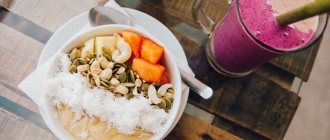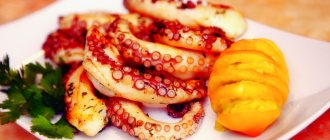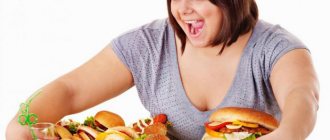One of the common misconceptions of those losing weight is to think that the more filling the product, the more calorie it contains. This idea leads to erroneous tactics. Namely, to dosing the diet according to the feeling of hunger. After all, according to these ideas, low-satisfying food is, by definition, low-calorie, which means it helps you lose weight. Agree, most people think and act this way. They build their diet by trying to feel hungry all the time.
How it works?
Let's figure out how the process of suppressing appetite occurs in our body, as well as the normal functioning of metabolism. The thyroid gland is primarily responsible for this process. She loves foods with iodine, which allow her to maintain the desired balance in her metabolism. If the metabolism is in order, it means that body weight does not increase, because. what you eat “burns.” Products containing a lot of iodine are known to everyone: these are any sea fish and all seafood - especially kelp, pears, onions; Iodized salt can also be included in the diet, but it is better to replace it with sea salt.
We also have the task of deceiving our own stomach, which has a direct connection with the “flight center” - the brain. As soon as you are left without work, you immediately get a signal “up”: SOS! Hunger! And the brain orders you to immediately find and eat something to calm the brawler. You can trick your stomach by giving it low-calorie foods that are difficult to digest. There are quite a lot of vegetables rich in fiber, which are great for reducing appetite. Fiber in the stomach increases in volume and causes a feeling of fullness, but does not add calories.
There are also foods, a small amount of which improves mood and reduces appetite due to the production of the “joy hormone” seratonin. You know, these are also simple and well-known products: cheese, cottage cheese, oatmeal, bananas, nuts, as well as legumes - beans, lentils, peas, etc.
Plus – dark chocolate with a high cocoa content. Many nutritionists advise eating 2-3 small pieces of dark chocolate after a working day - in this way you can reduce your appetite to a minimum, and in the evening a light and low-calorie dinner will be enough for you. Chocolate should not be bitten immediately - it is better to suck it for several minutes, like a lollipop, so that the brain receives signals for as long as possible that the body is receiving calories. By the way, we will actually get the required amount of calories, and there are enough nutrients in chocolate.
Considering the glycemic index
Products that resist appetite can be different - vegetables, fish, fruits, and dairy products. They have one thing in common: a low glycemic index. A study by British scientists from Cambridge states that white bread, many cereals and sweets have a high glycemic index, while fruits, most vegetables and dairy products have a low glycemic index. They increase the production of hormones that suppress appetite and send a signal that the body is full.
This was confirmed by the results of a study in which participants ate low-GI foods for breakfast and as a result had 20% higher plasma GLP-1 levels and 38% lower insulin levels compared to those who ate high-GI foods. Note that this is the first study in which experts were able to clearly illustrate the effect of low GI food on the production of GLP-1 and satiety in the body.
Blood sugar levels remain normal when there is enough chromium in the body - the feeling of hunger is reduced. Sources of chromium include wholemeal wheat flour, wheat germ, brewer's yeast, liver, black pepper, lemon balm, and cheese.
Glycemic index table for various foods:
| Carbohydrates with a high glycemic index ("bad" carbohydrates) | Carbohydrates with a low glycemic index ("good" carbohydrates) | ||
| fried potatoes | 95 | bran bread | 50 |
| mashed potatoes | 90 | unprocessed rice grains | 50 |
| honey | 90 | peas | 50 |
| carrot | 85 | unprocessed grains without sugar | 50 |
| cornflakes | 85 | cereals | 40 |
| sugar | 75 | buckwheat | 40 |
| white bread made from premium flour | 95 | rye bread with bran | 40 |
| refined cereals with sugar (muesli) | 70 | fresh fruit juice without sugar | 40 |
| chocolate | 70 | wholemeal pasta | 40 |
| boiled potatoes | 70 | Red beans | 40 |
| biscuits | 70 | dry peas | 35 |
| corn (maize) | 70 | dairy | 35 |
| White rice | 70 | lentils | 30 |
| black bread | 65 | wholemeal pasta | 30 |
| beet | 65 | chickpeas | 30 |
| bananas | 60 | fresh fruits | 30 |
| jam | 55 | canned fruit (no sugar) | 25 |
| dough made from flour without bran | 55 | dark chocolate (with cocoa content more than 60%) | 22 |
| fructose | 20 | ||
| soybeans | 15 | ||
| green vegetables, tomatoes, lemon, mushrooms | less than 15 | ||
What is a nourishing product?
Satisfying foods are foods that make you feel full. It is desirable that this feeling lasts as long as possible, which will allow the person to forget about food until the next meal. What does satiety depend on? Nourishing products must meet the following criteria:
- have sufficient volume to fill the stomach;
- move through the gastrointestinal tract as slowly as possible, maintaining a feeling of fullness for a long time;
- contain sufficient amounts of nutrients for saturation;
- ensure gradual rather than rapid absorption of nutrients, which allows you to maintain a concentration of nutrients in the blood sufficient for a feeling of satiety for a long time.
How long you feel full after eating depends on a number of factors, but your blood sugar level is particularly important. The faster it falls, the faster somatic cells absorb glucose from the blood and the sooner the person feels hungry again. There are studies that show that even the aroma of food can regulate the feeling of fullness.
You should familiarize yourself with the list of foods that can make you feel full for a long time, so you can reduce the number of calories entering your body. According to nutrition experts, there are 20 foods that help us feel fuller for longer.
Anti-appetite products
Apples. As American nutritionists have proven, by snacking on one apple before a meal, a person eats 15% fewer calories during a meal. In addition, during the digestion of apples, like other fruits, our body produces the hormone GLP-1, which sends satiety signals to the brain.
Hot red pepper. Nutritionists have found that if you eat a piece of chili pepper before eating, the feeling of hunger is dulled. The reason for this is capsaicin, which makes peppers so hot. Capsaicin can not only reduce appetite, but also speed up energy production processes in the body, thereby actually replacing exercise.
Seaweed. According to Dutch scientists, seaweed, once in our stomach, turns into a gel, and this allows us to reduce appetite by a third, giving a person a feeling of fullness for a significant period.
Scrambled eggs for breakfast. Eggs, which are rich in protein, keep you feeling full for a long time throughout the day. Water. A glass of water drunk before a meal reduces the feeling of hunger.
Green tea. The catechin found in green tea stimulates calorie burning, and three cups of green tea daily increases the rate at which your body produces energy by 40 percent.
Lemon. The pectin contained in lemon removes excess fat from the body and also slows down the digestion process.
Garlic. Due to the presence of a special component of garlic - allicin, which produces a specific odor, a clove of garlic will reduce the feeling of hunger and also stimulate the production of the hormone adrenaline, which speeds up metabolism and burns excess calories.
Useful replacement
Instead of confectionery products, which constantly add fat, sugar and extra calories to us, eat fruits, dried fruits and honey. They contain fructose - it successfully replaces sweets and reduces hunger, and there are much fewer calories than in any usual dessert. Plain clean water or juice reduces appetite well.
It is better to drink mineral water, but not carbonated water. Of course, you need to drink 20-30 minutes before meals; You should not drink after meals - this slows down digestion, as gastric juice is washed away.
Ginger tea helps reduce appetite. Grate the ginger and add 1 tsp. gruel with boiling water (2 cups), infuse and add honey (1 tsp). They drink this tea before meals: appetite decreases, metabolism speeds up, and sexual activity also increases - and from this we definitely become more beautiful.
Your appetite at lunch will decrease significantly if you eat a beauty salad in the morning at least 2-3 times a week. It is prepared simply and quickly: 2 tbsp. oatmeal, 1 tbsp. chopped walnuts, finely chopped half an orange, grated apple mixed with 1 tbsp. honey, pour a glass of low-fat yogurt over everything, stir and leave for 10 minutes.
If you really want to eat, you can eat this unusual sandwich: put a sliced ripe banana on a small piece of black bread. Brown bread contains fiber, and bananas contain a lot of glucose: the stomach will start working, and a signal will be sent to the brain that food has entered the body.
For lunch, eat clear soups - low-fat meat, fish, or even better, vegetable broth. This soup fills the stomach and satiates better and faster than main courses, and it has fewer calories.
You can also have a snack with a piece of low-fat cheese or a boiled egg, and drink green tea with a little honey. Curdled milk, fermented baked milk, kefir and natural yogurt also satisfy your hunger for a long time - you won’t feel like eating for several hours.
Product saturation index
Hearty foods that don't make you gain weight should have:
- Average calorie content.
- Low glycemic index.
- High percentage of fiber.
Watermelon, 38 kcal per 100g
Watermelon is one of the lowest calorie foods, and three to four slices are enough to feel full.
Potatoes, 161 calories per potato
Potatoes are the most satisfying product; they give you a feeling of fullness 3 times higher than a slice of white bread.
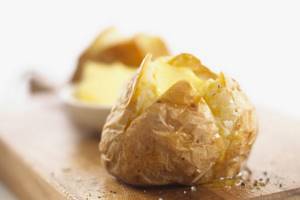
Eggs, 78 calories each
An egg is not just a very healthy product, it is rich in proteins that help satiate you. By eating one egg for breakfast, you significantly reduce your appetite over the subsequent time and do not add an extra 330 calories to your reserves.

Oatmeal, 187 calories per 50 g serving
Oatmeal is the most nutritious of cereals. The property of this product to have a beneficial effect on the gastrointestinal tract is well known, which makes it indispensable in dietary nutrition. The fiber contained in oatmeal promotes good digestion. In addition, it can lower cholesterol levels.
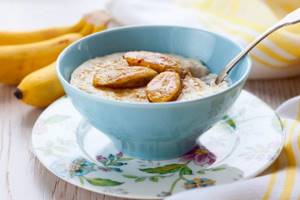
Fish, on average 70 kcal per 100g
The body does not create protein reserves. All eaten proteins are sent either to replace protein molecules in cells and tissues (plastic function), or to a lesser extent for energy needs. We can’t eat a lot of proteins – we have nowhere to put them. Hence the conclusion: protein foods are also quite filling.

6. Natural yogurt, 66 kcal per 100g
Low-fat yogurt, which, by the way, is easy to make at home, helps with weight loss because it increases the feeling of fullness. Made without added sugar with a natural starter, Greek yogurt is a natural source of protein, minerals and milk fat. To make your yogurt truly nutritious, add a handful of nuts or cereal (they're great here).
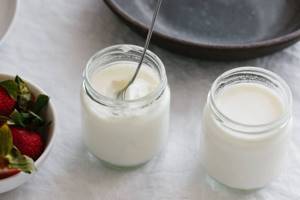
7. Apples, 47 kcal per 100g
Apples are one of the few fruits that contain pectin, which naturally slows digestion and promotes satiety. An apple eaten after lunch will give the body a final dose of complex sugars and vitamins and help maintain a feeling of fullness for a long time. Try adding apples to salads, cereals and sandwiches - it will expand the boundaries of your relationship with these wonderful fruits.
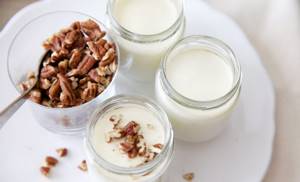
8.Oranges, 59 calories per fruit
Oranges are one of the most filling fruits, thanks to the fiber they contain. In a list of 38 filling foods compiled by Australian nutrition scientists, oranges rank first among all fruits and citrus fruits. Pamelo, lemons and tangerines not only satisfy hunger well, but also promote weight loss, and also replenish the reserves of vitamins and microelements that are so necessary in winter.
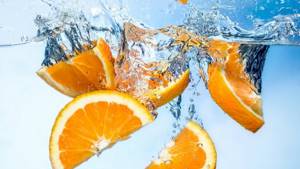
Durum wheat pasta, 172 calories per 50g serving
It's easy to get confused by the inscriptions on labels. Some manufacturers indicate on packages of pasta made from wholemeal flour “pasta made from durum wheat,” while others indicate “pasta made from wholemeal flour.” But in fact, they are one and the same thing: wholemeal flour made from durum wheat.

Dark chocolate, 170 calories per 28 g
Approximately a quarter of a 100g chocolate bar will help you eat much less of other foods, as the ingredients in this treat slow down the digestive process. In addition, a few squares of dark chocolate act as a remedy against eating a lot of sweets, as well as salty and fatty foods.
Pine nuts, 95 calories per 14 grams - approximately 84 nuts
The fatty acids contained in pine seeds are very good for the heart and, in addition, they contribute to a long-lasting feeling of fullness. If you are used to eating almonds, we advise you to replace them with pine nuts.
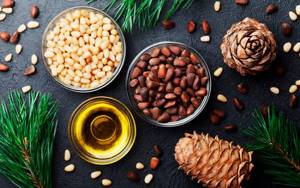
Soft cheeses, 76 calories per 28 g
Fresh goat cheese or any other type of feta contains concentrated linoleic acid, which promotes satiety and also helps burn fat in the body. Processed cheeses also contain concentrated linoleic acid in fairly large quantities, so you can give them your preference, but try to limit yourself to one cheese.

Skim milk, 86 calories per glass
Many of us are accustomed to considering milk as the main product of baby food, not suspecting that the beneficial qualities of milk are invaluable for the adult body. The proteins it contains, for example casein, perfectly saturate us. In addition, milk also contains concentrated linoleic acid.
Cottage cheese, 169 calories per 100 g
This product contains proteins, fats, vitamins, mineral salts and is a dietary product. Cottage cheese can be low-fat, full-fat and semi-fat. Eat any for your health!

Mushrooms, 20-40 kcal per 100 g
Champignons (27 kcal per 100 g), oyster mushrooms (38 kcal per 100 g), chanterelles (23 kcal per 100 g) or boletus mushrooms (31 kcal per 100 g) will be excellent additions to porridges, snacks or dressings and sauces. It is more advisable to eat boiled or baked mushrooms than pickled ones.
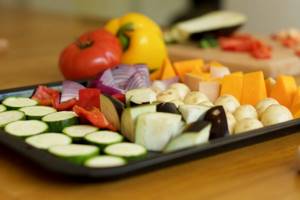
Pumpkin, 22 kcal per 100 g
Pumpkin is an indispensable product for slimming people! You can bake, stew, make pancakes and porridge.
Porridge: you need to take 200 g of pumpkin and cut it into small cubes. Simmer with added water for 30 minutes. Then add any cereal of your choice (oatmeal, millet flakes or rice) in the amount of 2 tbsp. l. and keep on low heat for the same amount of time. It turns out to be a very tasty porridge; it is not forbidden to dilute it a little with skim milk.
Noble deception
And a few more simple recommendations, which, however, are not known to everyone.
Skimmed dry milk helps to quell an increased appetite: you just need to chew it for a while (about 1 tsp), swallow and wash it down with a small amount of water.
To avoid wanting to eat before bed, eat a small piece of lean boiled meat at dinner - this will not only reduce hunger, but also help the body burn fat during sleep.
Eat fish dishes 2-3 times a week - as already said, this helps the thyroid gland.
Try to add legumes to vegetable salads - this will fill you up faster and improve digestion.
Season salads with vegetable oil or kefir; Try to use sour cream less often, and choose low-fat, and avoid mayonnaise altogether.
You should eat at least 300 g of vegetables per day, raw or stewed - they contain a lot of fiber and vitamin C, which our body needs in large quantities every day.
If you feel hungry but know you shouldn't, rinse your mouth with mint water - you can do this several times throughout the day.
How to gradually switch to a water diet?
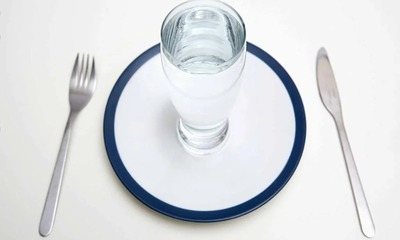
Almost everyone can cope with such a task, because they have already experienced such an experience during colds, when appetite disappears completely.
The best assistant in switching to a “water diet” will be vegetarianism . A person who can easily go without meat for several days will not suffer if he does not eat for a whole day or even two.
After the milestone of “24 hours without food” has been passed, you can aim for longer periods of recovery.
